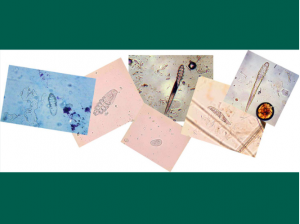398 – Getting Under the Skin: Demodex and other Mites

Getting Under the Skin: Demodex and other Mites
Dr. Marty Greer talks about Demodex, demodectic mange and other skin mites that can cause problems in dogs.

Slides of demodex mites from www.capcvet.org
“We can start with the history of Demodex, which used to be very serious. When a dog was diagnosed with Demodex back in the day, it was sometimes a death sentence,” Greer said.
“Over the years we’ve seen a huge change in the medications that we have as an option to treat Demodex with and it is no longer the scary, awful death sentence it once was. I still think we need to talk about Demodex as far as clinical signs and what that means for a breeding program and what it means for your dog’s health.
“We know that it is an autoimmune mediated disease. We believe it’s a B cell deficiency that the immune system doesn’t have actively functioning or well enough functioning B cells in some of these patients. Every single dog at birth is exposed to Demodex as soon as it’s exposed to his mother skin …. It is part of the normal flora, in very small numbers. Our immune system typically keeps it under control and if your immune system isn’t doing what it should be doing then that’s when the numbers are might increase to the point that you have lesions.
“There’s basically two categories of Demodex. There’s localized Demodex and generalized. So localized is exactly what you describe: the baby puppy with a little hair loss under their eye, maybe a couple of patches someplace on their leg or their trunk. Just a little patch of hair loss. It’s not uncomfortable, it doesn’t look angry. It’s just this little patch that you don’t see hair, frequently around the eyes but not exclusively there. A lot of people come in and they’re like ‘Oh yeah well he’s just been fighting with his brother it’s no big deal’ and you do a skin scraping and you find 30 Demodex. Well guess what? You have Demodex, you don’t just have a puppy fighting with his brother. So the first thing we will always want to do when we see a skin lesion on a young dog is to do a skin scraping.
“I think it’s important that you have a diagnosis. Especially if you have a breeding program and you need to know whether you have Demodex in your life. So I think we shouldn’t blow off doing skin scrapings. Demodex show up pretty readily … there’s a number of different kinds of mites that we can see in dogs and cats and Demodex is one of the easiest ones to find on the skin scraping.
“Generalized demodex can happen in puppies but it can also happen in adult dogs. If they are immunosuppressed. If they’ve got an immune system disorder. If they’ve been on too much Prednisone or other kinds of cortisone. Is thier nutrition hasn’t been good. If they’ve been on chemotherapy. If they’ve recently been in heat, they have cancer, if they have diabetes.
“Localized Demodex, it appears, has a genetic component. We see it really commonly in dogs like with Chinese shar-pei. But we see no indication, there’s no good research that shows generalized Demodex is genetic.”
Find more information on demodex here.
Our Valued Corporate Sponsors:
Our Esteemed Advertisers:
Our In-Kind Supporters:
KNOWLEDGE IS POWER — FRANCIS BACON
When you become a patron of Pure Dog Talk you’ll tap into an exclusive community of experts to help you and your dog be blue-ribbon best at whatever you do with your purebred dog! Your support helps keep the MP3's rolling at Pure Dog Talk!
As a supporter, you’ll immediately gain access to the weekly Pure Pep Talk SMS, Pure Pep Talk private Facebook group, and priority emails. Patrons can choose to level up to the After Dark Zoom and a Patrons Digital Badge for their website— even a private counseling session with Laura on any topic.

DON'T MISS AN EPISODE!!












